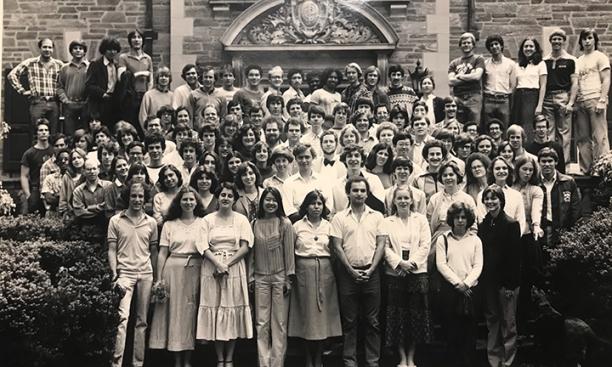
In a March On the Campus story about recent trends in undergraduate women’s leadership, PAW made a mistake reporting the year when the first woman took office as president of an eating club (we were off by a few decades). But there was a silver lining: Readers who noted the error suggested that we connect with some of the women who were campus leaders, on Prospect Avenue and elsewhere, in the 1970s, ’80s, and ’90s. Intern (and recent graduate) Arika Harrison ’21 jumped at the opportunity. Here, she reflects on a few of the stories she collected.
“I was in Cuyler Hall,” Lori Irish Bauman ’81 told me. “It was an all-female entryway. The bathroom in the basement had ‘MEN’ painted on it. Somebody had written, on a piece of paper, ‘WO’ and taped it in front of ‘MEN.’ That was the only sign that Princeton was not fully accommodating to women.”
Bauman, who was an editor for The Daily Princetonian, described her experience at Princeton as one where she never felt that being a woman held her back in any way, despite women students’ position as a new presence (and a clear numerical minority) on campus.
Classmate Mary Estelle Ryckman ’81 similarly recalled that on the relatively new women’s rowing team, the women were not allowed to go to the second floor of the boathouse because that was reserved for men. Yet, when asked generally if she felt a biased gender dynamic at Princeton, especially when she became president of Charter Club, she said, “We didn’t feel like that when we were there. … None of us felt that we were constrained in taking a leadership role.”
Amy Briggs ’96, who served as president of Dial-Elm-Cannon more than a decade later, told me about being a woman on campus, and whether gender had changed her experience at Princeton, that “I don’t think I even noticed it. I think I was oblivious.”
These stories were a common theme among the women I spoke to over the course of reporting on the history of women’s leadership at Princeton. Alumnae would tell me stories that, to me as a female member of the Class of 2021, seemed absolutely outrageous. Women couldn’t use the weight room designated for the sport they were participating in? The bathroom in an all-women’s hall was labeled as “MEN”? My immediate reaction was outrage with the University, and a feeling that women at the time must have felt unwelcome on campus.
Yet, every woman I spoke with for this story insisted that she had not often thought about her gender while at Princeton. For many, it seemed they had never seen a serious problem with the presence of male-only eating clubs, or older men at Reunions who discussed the newly coed University as though women were not standing under the same crowded, humid tent. These stories were told to me as though they were merely facts of life, not issues worth getting worked up over.
I expected to hear about how tough it was to always have to prove yourself as a woman at a recently-all-male institution. How hard it must have been to feel like you have to represent your gender (or your race, or your sexuality) in an environment that was not created to include you. I think that is a feeling many of my undergraduate peers feel today, and a topic that I have discussed often on campus, along with specific examples, from the lack of clearly gender-neutral bathrooms in dorm buildings to the disproportionately few faculty of color.
However, what I found was a generational difference in perception of these kinds of issues. The women I interviewed knew the University was not designed to accommodate them and told me anecdotes of times when it was clear there had not always been women at Princeton. Despite that, though, they insisted they had always been, in so many words, at least at peace with this dynamic.
The women I spoke with seemed to assume that they should fight for their place on campus. From my perspective, that these women felt at all that they were not entirely welcomed in every space on campus is a severe problem. Certainly there is something to discuss about bathrooms not labeled inclusively, or alumni openly discussing whether or not I should have been allowed to attend Princeton. Such dynamics are challenging for minority populations of all kinds, and weeding out these issues takes acknowledgement and action to make campus more inclusive.
I think the real progress we have made since women were first admitted at Princeton is to acknowledge that if women, or people of any other minority group, feel as though they have to fight for their place on campus, the University has not succeeded in creating a truly inclusive and equitable environment.
The women leaders I spoke to paved the way for women to attain more equality on campus. However, while acknowledging their exceptional work is important, it is paramount to keep in mind that the goal is not to have every exceptional woman be able to obtain a leadership position. The goal is to create a world where it is entirely commonplace to see women in leadership — where there is no need to see them as exceptional and no need for them to work harder than others to earn respect.
